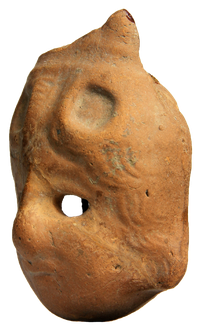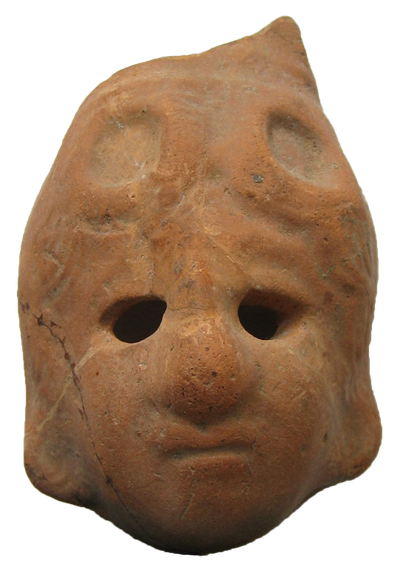Miniature female mask from the north-western provinces
Description: The broad, roundish-oval face is framed by finely streaked hair arches that spring up a little at the bottom. The full, smooth cheeks merge into a round chin. A large nose protrudes from the receding profile. The empty open eye sockets are almost horizontal above, semicircular below. The mouth is closed; the horizontally indicated lower lip is narrowly overlapped by the curved upper lip. On the forehead, two square depressions with rounded corners and sculptural marginal ridges can be recognised, above them a shallow, slightly curved groove, as well as a fragmented obliquely rising element on the left. On the back, a roof-like curved bar with two pierced holes is attached.
Commentary: Due to the recessed eye openings and the lack of a neck attachment[1], the object is to be regarded as a mask, and because of its small size as a miniature mask. Other characteristic features such as the closed mouth and the ornamental, peculiarly crowned hairstyle assign it to a group of about 40 similar specimens known so far from the north-western Roman provinces[2]. The comparative objects come from sites on the left side of the Middle and Lower Rhine, between Bingerbrück and Nijmegen, and from the banks of the Moselle[3]. Pieces recovered from dated graves suggest an origin in the 2nd half of the 3rd century and in the 4th century AD[4]. Some of them still preserve the remains of colourful painting, whereby the use of gold, e.g. on the hair, is particularly striking. It is possible that golden ear jewellery was also depicted[5], but the fine streaking that is indicated at the lower end of the coiffure next to the cheeks, also in the Giessen mask, speaks in favour of the indication of hair[6].
Well-preserved specimens suggest that the plastic bulges around the round or square indentations originally emerged from ornamentally arranged strands of hair[7]. In addition, there is a variable crowning. In the case of the Giessen mask, it is no longer possible to decide whether the rising obliquely bordered element belonged to a stephane[8] or to an attachment[9] divided in two lengthwise.
As with the parallels, the perforations on the back prove that the objects were intended for hanging[10].
A perusal of the miniature masks in illustrations and originals suggests a division into two main types[11]. While the first type is characterised by a relatively flat, narrow face with an accentuated chin and downwarded corners of the mouth, as well as thick bundles of curls nestled close to the cheeks, the second is distinguished by a rather broad, more depth-oriented face with round cheeks. The forehead hair is ornamentally curled in both types, but no strands are visible in the second[12]. This also applies to a piece recovered from the Cologne necropolis[13], to which the Giessen T II-2 specimen is closest[14].
In representatives of the first type, on the other hand, the curled forehead hair is streaked[15]. Together with the longitudinally divided headdress[16], they are reminiscent of mosaics from Elis and Piazza Armerina. Here the strands form ornamental vertical loops divided by thin strings[17]. The mosaic at Elis shows the god Apollo and the inscription-named Muses, all in the form of their characteristic attributes. Only Polyhymnia, the muse of pantomime, is depicted as a female mask with elaborate hair loops held by a ribbon[18].
Miniature masks presumably allude to larger masks made of other materials worn by mimes at dances. The text and content of the performance are taken from Greek tragedies and are performed by a singer or chorus, accompanied by flute music and rhythmic instruments. The effect of the wordless dance reels is based solely on body movements and gestures. After its beginnings in Greece in the 4th century BC, this form of entertainment enjoyed particular popularity in the Roman imperial period. Its success continued into the 6th century AD[19].
Although most miniature masks were found in the Cologne area, they were obviously not made there. This is because the Cologne workshops used an iron-free clay that was strikingly white or light beige when kilned[20], in contrast to the reddish-brown clay colour of the miniature masks. Moreover, the production of mould-made terracotta sculpture is no longer documented in Cologne after the end of the 2nd century AD, but it is for the centre of Trier-South, where it lasted until the 4th century AD. Here, the corresponding moulds and misfired pieces of yellow-brown and -red clay were also found[21]. The miniature masks could easily reach their destinations on the waterways of the Moselle and Rhine[22].
Determination: 2nd half of the 3rd century AD, Germania inferior, Belgica (Roman north-western provinces).
 |
 |
 |
[1] L. Summerer, Hellenistische Terrakotten aus Amisos (Stuttgart 1999) 65.
[2] H. Rose, Spätrömische Miniaturmasken in Germanien und der Gallia Belgica, Xantener Berichte 13, 2003, 325-351.
[3] Rose, Miniaturmasken 2003, 330.
[4] Andernach Inv. 785a. Inv. 785; Köln RGM 3646. Köln RGM Inv. 29/1113, Jakobstraße, Rose, Miniaturmasken 2003, 337. 340; Nimwegen Inv. 134/12. Ludwigshafen Inv. a 15 und a 1035, both from the Gondorf cemetery (district Mayen-Koblenz), ibid. 340. 344.
[5] Rose, Miniaturmasken 2003, 326.
[6] G. M. E. C. van Boekel, Roman Terracotta Figurines and Masks from the Netherlands (Groningen 1987) 788 fig. 132; Rose, Miniaturmasken 2003, 337 no. 1 pl. 338.
[7] Van Boekel 1987, 789 fig. 134. 135.
[8] Van Boekel 1987, 788 f. fig. 132. 135.
[9] „ reminiscent of animal ears“, van Boekel 1987, 798, e.g. p. 789 fig. 134.
[10] Additional piercings at the lower end of the hair section led to the assumption in the Ludwigshafen a 15 specimen that the mask was attached to a base [box?], Rose, Miniaturmasken 2003, 344.
[11] Rose, sum figuli lusus… Die römischen Terrakottamasken in den Nordwestprovinzen. Herkunft – Herstellung – Verbreitung – Funktion. Diss. Köln 2000, 85 note 351; id., Miniaturmasken 2003, 337-348; van Boekel 1987, 788 f. fig. 131. 133; Rose, Miniaturmasken 2003, 342 no. 12. 13 pl. 341.
[12] The finely streaked short hair arches described above, which frame the face, only begin below the 'spectacle-like formations', s. van Boekel 1987, 788 fig. 132; Rose, Miniaturmasken 2003, 340 no. 7 pl. 338.
[13] Inv. no. 29, 1113, Cologne, Jakobstraße/Severinstraße grave 66, Serie Andernach Version B, Rose, Miniaturmasken 2003, 340 no. 6 pl. 338.
[14] I would like to thank Ágnes Adam, Friederike Naumann-Steckner and Hannelore Rose, RGM Cologne, for photos, photocopies, references and the opportunity to study the originals.
[15] Van Boekel 1987, 789 fig. 134. 135; Rose, Miniaturmasken 2003, 344 no. 19. 22 pl. 343.
[16] Van Boekel 1987, 789 fig. 134; Rose, Miniaturmasken 2003, 342 no. 16 pl. 341; 344 no. 22 pl. 343; 346 no. 31 pl. 347.
[17] Jory 1996, 13 f. fig. 9. 10.
[18] Jory ebenda, 13 fig. 9.
[19] M. Bieber, The History of the Greek and Roman Theater (Princeton 1961); DNP 9, 2000, s. v. Pantomimos (L. Benz); van Boekel 1987, 786-799; H.-U. Cain, Chronologie, Ikonographie und Bedeutung der römischen Makenreliefs, BJB 188, 1988, 181; M.-H. François-Garelli, Danser le mythe. La pantomime et sa réception dans la culture antique. (Louvain – Paris – Dudley, MA 2007); E. J. Jory, The literary evidence for the beginnings of imperial pantomime, BICS 28, 1981, 147-161; id. Ars Ludicra and the Ludus Talarius, in: A. Griffiths (Hrsg.), Stage Directions. Essays in Ancient Drama in honour of E. W. Handley, BICS Suppl. 66, 1995, 139-152; id., The Drama of the Dance: Prolegomena to an Iconography of Imperial Pantomime, in: W. J. Slater (Hrsg.), Roman Theater and Society. E. Togo Salmon Papers I (Ann Arbor 1996) 1-27; id., Some cases of mistaken identity? Pantomime masks and their context, BICS 45, 2001, 1-20; Rose 2000, 84-90.
[20] H. Rose, Fragmente römischer Terrakottamasken aus der Domgrabung, Kölner Domblatt 68, 2003, 329.
[21] Nos. 37. 38 and 40 come from the Trier-South pottery area on the Pacelli bank, no. 39 from the St. Matthias site in Trier., Rose, Miniaturmasken 2003, 332. 334. 348; van Boekel 1987, 786 f. fig. 130.
[22] Rose, Miniaturmasken 2003, 334.

